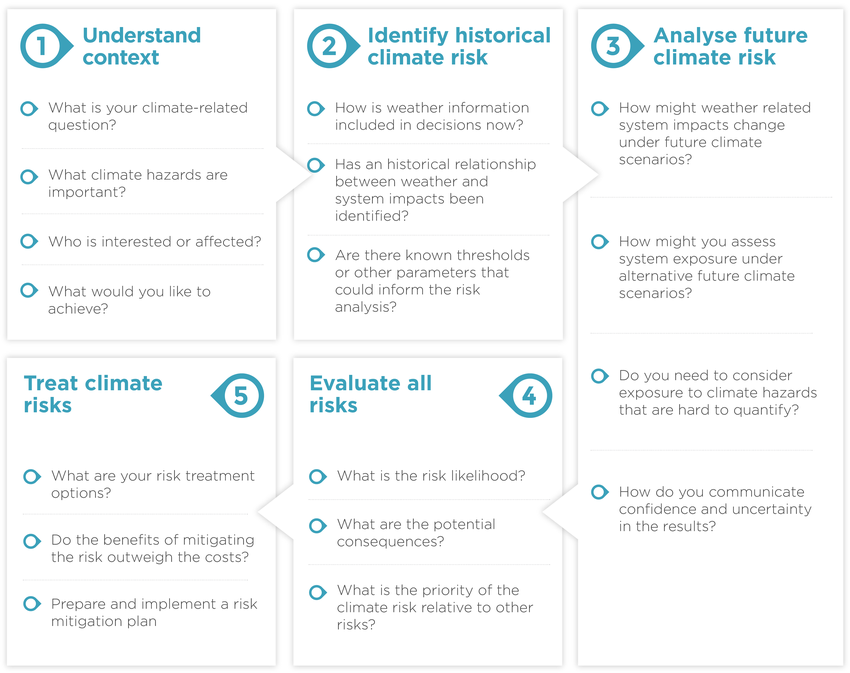Climate Change in Australia
Climate information, projections, tools and data
About ESCI
- Background
- The Risk from Climate Change
- The ESCI Climate Risk Framework
- Who Was Involved?
- Project Limitations
- Downloads
Background
The Electricity Sector Climate Information (ESCI) project was initiated in response to the Independent review into the future security of the National Electricity Market: Blueprint for the future (known as the ‘Finkel Review’) The project, funded by the Department of Industry, Science, Energy and Resources, and was undertaken by climate scientists from CSIRO and the Bureau of Meteorology in collaboration with the Australian Energy Market Operator (AEMO), and in partnership with electricity sector stakeholders. It ran from 2019 to 2021.
The project has delivered high resolution (5–12 km) climate projection data across the National Electricity Market (NEM) at sub-daily intervals to the year 2100. The project has also tailored guidance and insights to enable the electricity sector to assess climate risks and to plan for the future with greater confidence.1
As a result of the ESCI project, climate risk—including risk related to future weather—can now be consistently integrated into sector planning and risk modelling using a standard process and guidance.
The Risk from Climate Change
Weather and electricity are interconnected. Weather is the 'fuel' for solar, wind and hydro electricity generation. Electricity demand is strongly dependent on temperature. Electricity infrastructure performance is directly affected by hazards such as extreme heat, droughts and severe winds; there are also acute, systemic consequences from severe and high-impact weather.
The AEMC reports that 95.6% of blackouts are caused by sudden poles and wires breakdowns in the grid—typically caused by weather events such as storms and bushfires.
The impacts of climate change on Australia's future energy system will become increasingly significant (Table 1).
Changing climate hazard | Electricity system vulnerability |
|---|---|
Rising temperatures Increases in average and extreme temperature (very high scientific confidence). |
Reduces generator and network capacity, increases demand, increases failure rates and maintenance and replacement costs. |
Increased frequency and severity of bushfires Increase in extreme fire weather (medium-high confidence). |
Threat to most assets, with a particularly high operational risk to transmission and distribution lines due to heat and smoke. |
Extreme winds Decrease in number of high wind events and cyclone frequency, possible increase in severe Category 4–5 cyclones (low-medium confidence). |
High winds reduce the capacity and threaten the integrity of transmission lines, making it an important consideration for network capacity assessments and design specifications. Wind generation is sensitive to a reduction in average wind-speed as well as to the frequency and magnitude of destructive gusts. |
Increased variability or reduction in rainfall, dam inflows and flooding Decrease in winter/spring rainfall and increase in extreme rainfall events (medium confidence). |
Reduces water available for hydro generation. Increases requirement for desalination and associated energy demand. Reduced soil moisture may increase damage from lightning and reduce thermal conductivity of underground power lines. |
Compound extreme events Increase in frequency and magnitude (low confidence). |
Extremes in multiple climate variables occurring simultaneously or in close sequence can cause substantial disruption. These events can be exacerbated by associated non-climatic factors such as infrastructure failure or staff fatigue. |
A climate risk assessment is likely to be relevant for:
- managing safety and reliability of assets in the future
- identifying the potential for asset and value destruction
- understanding the potential for changes in future cash flow and profitability
- understanding consumer outcomes from possible weather impacts on electricity supply and demand
- designing new asset specifications for future operating conditions
- calculating market benefits for regulated investments, considering changes to operating conditions of the integrated power system
While climate change information is most relevant for mid- to long-term planning (greater than 10 years), some climate risks are becoming apparent over shorter periods. Extreme temperatures are becoming more frequent, which has implications for consumer demand forecasts. Early evidence of increasing bushfire risks has implications for fuel load management (Figure 1). Climate change is superimposed on natural weather and climate variability,2 and while historical records provide a good indication of where risks may emerge, future risks are likely to be underestimated.

Figure 1 Change in the number of dangerous fire weather days from 1950 to 2010. (Source: Dowdy 2020 )
The ESCI Climate Risk Framework
The ESCI project is providing a credible, relevant, quality-assured framework for assessing the risk that climate change presents to critical NEM infrastructure and capacity so that the impacts of climate change can be assessed and, where practicable, mitigated. This framework includes:
- a five-step climate risk assessment method designed to integrate with organisational assessments of other risks, based on ISO 31000 and supported by a user guide
- advice on selecting and using appropriate climate information
- exemplar case studies for using climate data in a risk assessment
- supporting information: technical reports , a glossary , key climatology concepts relevant to the electricity sectors, webinars and training materials
Figure 2 shows the ESCI climate risk assessment method. The steps incorporate elements from:
- International Standard ISO 31000 Risk Management , which provides a general framework that is widely used internationally
- International Standard ISO 14090 Adaptation to Climate Change , which is consistent with ISO 31000 and well aligned with climate risk assessment for the electricity sector
- Australia's Climate Compass , which is also consistent with ISO 31000, with a focus on climate risk assessment for policy and programs
- Australia’s National Disaster Risk Reduction Framework
- Australian Standard AS 5334 Climate change adaptation for settlements and infrastructure
- Climate Risk and Resilience - Industry Guidance Manual (Energy Networks Australia 2014; ENA DOC 036-2015), a detailed guide to risk assessment for energy networks that provides advice that can be used by other parts of the sector
More information about the framework is available in the ESCI User Guidance

Figure 2 The ESCI Climate Risk Assessment Framework—based on ISO 31000 and incorporating elements from other relevant risk and adaptation frameworks.
Note: Where the climate risk assessment framework, and the recommended climate information, indicate a significant risk from climate change, the project recommends that sector organisations consult with specialist climate service providers.
Who Was Involved?
The project worked with a reference group of stakeholders from across the electricity sector to develop the climate risk assessment framework and supporting documentation. This reference group provided the climate-sensitive decisions and processes for the exemplar case studies and worked with the project to complete the risk assessments.
Other contributors to the project and case studies included representatives from the Australian Energy Market Operator, electricity generators, transmission network service providers, distribution network service providers, the Energy Network Association, consultants, consumer groups and academia.
Project Limitations
The ESCI recommended approach to assessing the risk that climate change presents to the National Electricity Market is rigorous and will continue to be relevant as these risks change. The guidance material explains in detail how to identify relevant climate information, appropriate scenarios for future risk assessments and the importance of incorporating a range of projections.
However, climate projections are derived from climate models that have limitations. Uncertainties at regional and local scales over the next decade are strongly influenced by natural variability, which is hard to predict. Greenhouse gas emissions pathways change depending on global climate policy, economics, technology and behaviour; the atmosphere responds to changes in greenhouse gases in ways that are non-linear, and so the projections of future climate trends and extremes in climate hazards themselves will change.
The CMIP5 global climate models (GCMs) used by the project have coarse-resolution (about 100–150 km between data points) and provide useful information over the next two decades and beyond at global and continental scales. Some GCMs include regional errors, so the project has selected a subset of GCMs that perform well in the Australian region. Nevertheless, GCMs cannot adequately represent weather-scale (1–10 km) phenomena, so downscaling methods have been used.3 However, downscaled simulations may include regional errors, especially at the weather scale, the numerical precision of these data must not be confused with accuracy. The downscaled projections should be considered indicative, rather than precise, based on the best available information. Where possible, uncertainties have been estimated and confidence ratings have been provided.
Data from a new set of CMIP6 GCMs is currently being evaluated4 and new downscaling is being developed and evaluated. Over the coming decade, it is hoped that a paradigm shift in GCMs will enable simulations much finer resolution, avoiding the need for downscaling. Therefore, improved data sets are in the pipeline.
Finally, there are limits to our understanding of weather phenomena, and the chaotic nature of the atmosphere means that some phenomena are inherently unpredictable. Project time and resource constraints also necessarily limit the scope of the project. Therefore, topics which the ESCI project does not cover are:
- extreme wind projections (other than current risk from severe convective winds): new information on extreme winds, such as tropical cyclones and future risk from severe convective wind, may be provided by the Bureau of Meteorology in the future.
- compound extreme weather events: the ESCI project has provided a case study of compound extreme weather events identified from the climate projections,5 however the sector would benefit from a suite of these widespread events, and rare extreme or compound events. These are likely to be provided in the future by the new Australian Climate Service.
- bushfire risk: ESCI analysis is limited to bushfire weather and does not consider fuel loads, changing vegetation or ignition risks. The ESCI project uses the Forest Fire Danger Index (FFDI) as the best available indicator of bushfire weather. The new Australian Fire Danger Rating System is currently under development which will improve the existing system using the latest science on fuel types and fire behaviour. The electricity sector should access these advances as they are made available.
- projected changes in the intensity, frequency and duration of floods, hail, lightning, extreme sea level events and other weather scale events: information on these is available through the National Environment and Science Program Earth Systems and Climate Change Hub.
NOTES
1 Please see the Disclaimer and Licence Terms
2 See ESCI Key Concept Climate projection confidence and uncertainty.
3 See ESCI Key Concept Climate models and downscaling.
4 See ESCI Key Concept CMIP 6 projections.
5 See ESCI Technical Report Using compound extreme event case studies for decision-making, also ESCI case study—impact of extremes.
Downloads
DownloadAll figures (zip 521.2 KB)


